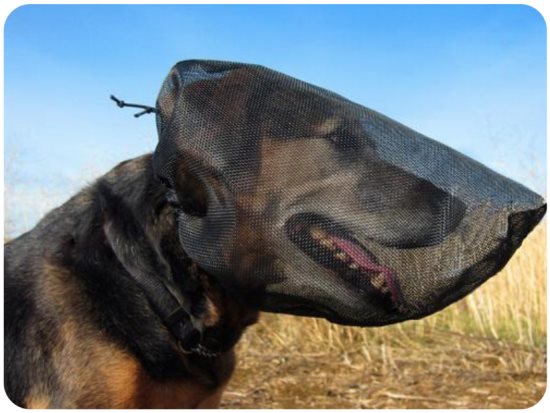| | Published May 12th 2021
| Common symptoms to look for in pets during foxtail season
| | | By Mona S. Miller, DVM |  | | The Outfox Field Guard (designed by a Bay Area local) is a basket of mesh that encircles the dog's head, allowing him to see effectively, but with small enough mesh that it's very difficult for a foxtail to penetrate through. Image provided |
For those of us in the veterinary field, we anticipate the start of "foxtail season" with some degree of dread, since these little plant awns can burrow into any part of an animal's body. Foxtails are the plant dispersal unit for a wild annual grass that is prevalent throughout California. Foxtail "season" starts in early spring, when the awns are initially green, but quickly turn to tawny tan/brown, and lasts through into fall. It is impossible to miss this grass plant if you go into any un-landscaped area.
 The name refers to the bushy spike arrangement at the top of the grass that resembles the tail of a fox - it is a cluster of spikelets attached to a main stem. Each cluster comes off the plant easily, and tiny barbs clasp onto material (socks, fur, etc.). Then, the sharp point at the base of the cluster allows it to move forward into the material. This is the plant's adaptation for dispersing its seeds throughout an area. For most wild animals that live in the same native environments that foxtails are found, their fur is short enough that the foxtail does not migrate into the skin. Instead, it is transported and dropped off, allowing for successful seed dispersal. However, for our domestic pets we often find that the foxtail point will migrate into tissue and thereby cause problems.
The name refers to the bushy spike arrangement at the top of the grass that resembles the tail of a fox - it is a cluster of spikelets attached to a main stem. Each cluster comes off the plant easily, and tiny barbs clasp onto material (socks, fur, etc.). Then, the sharp point at the base of the cluster allows it to move forward into the material. This is the plant's adaptation for dispersing its seeds throughout an area. For most wild animals that live in the same native environments that foxtails are found, their fur is short enough that the foxtail does not migrate into the skin. Instead, it is transported and dropped off, allowing for successful seed dispersal. However, for our domestic pets we often find that the foxtail point will migrate into tissue and thereby cause problems.
 I have seen foxtails in every part of an animal's body. Symptoms are related to the body part affected. Some areas are easier than others to find and remove the foxtails - such as in-between toes, the undersides of paws, ear canals and conjunctival lining of the eyes. Even in these areas, though, there may be significant pain associated with the foxtail, and its resultant inflammation and infection. Some dogs may need sedation or even anesthesia to remove it, especially if it has burrowed deep into tissue. Dogs who lick their paws, shake their heads and ears, and have swollen painful eyes should be checked for a foxtail.
I have seen foxtails in every part of an animal's body. Symptoms are related to the body part affected. Some areas are easier than others to find and remove the foxtails - such as in-between toes, the undersides of paws, ear canals and conjunctival lining of the eyes. Even in these areas, though, there may be significant pain associated with the foxtail, and its resultant inflammation and infection. Some dogs may need sedation or even anesthesia to remove it, especially if it has burrowed deep into tissue. Dogs who lick their paws, shake their heads and ears, and have swollen painful eyes should be checked for a foxtail.
 Other areas are more hidden - full anesthesia would be required in the majority of cases to visualize and remove foxtails in the throat and nose. The classic case of a dog inhaling a foxtail into his nose would be one running around in open space, and starting to sneeze violently. The sneezing may subside as the foxtail settles over the next few hours to days, but this is something to check with your veterinarian. Coughing and gagging are common symptoms when a foxtail (or blades of grass) gets stuck in the tonsil area.
Other areas are more hidden - full anesthesia would be required in the majority of cases to visualize and remove foxtails in the throat and nose. The classic case of a dog inhaling a foxtail into his nose would be one running around in open space, and starting to sneeze violently. The sneezing may subside as the foxtail settles over the next few hours to days, but this is something to check with your veterinarian. Coughing and gagging are common symptoms when a foxtail (or blades of grass) gets stuck in the tonsil area.
 Most dogs will demonstrate symptoms of foxtail abscess, but I recently anesthetized a small dog for a routine dental cleaning and evaluation, and found a medium-sized foxtail partly embedded under the tongue. This little dog had shown no symptoms of pain at all to her owners!
Most dogs will demonstrate symptoms of foxtail abscess, but I recently anesthetized a small dog for a routine dental cleaning and evaluation, and found a medium-sized foxtail partly embedded under the tongue. This little dog had shown no symptoms of pain at all to her owners!
 Foxtails in cats are much less common, possibly because cats are meticulous cleaners, but I have seen foxtails in cats' eyes and ear canals.
Foxtails in cats are much less common, possibly because cats are meticulous cleaners, but I have seen foxtails in cats' eyes and ear canals.
 When a foxtail gets embedded into tissue, it is only a matter of time before it will start to penetrate inside. Foxtails can form abscesses in the fat tissue under the skin, and also inside the lungs and abdomen. The deeper the foxtail migrates into the body, and the more it creates tissue inflammation around it, the harder it is to find. It is common to need two to four recheck probes in some cases, or even deep surgery to remove the affected tissue to find the foxtail hidden inside. Obviously, it is best to address a foxtail problem before it has advanced inside the body and requires subsequent surgical diagnosis and removal.
When a foxtail gets embedded into tissue, it is only a matter of time before it will start to penetrate inside. Foxtails can form abscesses in the fat tissue under the skin, and also inside the lungs and abdomen. The deeper the foxtail migrates into the body, and the more it creates tissue inflammation around it, the harder it is to find. It is common to need two to four recheck probes in some cases, or even deep surgery to remove the affected tissue to find the foxtail hidden inside. Obviously, it is best to address a foxtail problem before it has advanced inside the body and requires subsequent surgical diagnosis and removal.
 Prevention is difficult if your dog is an active, outdoors hiker, since the most effective prevention is avoiding any areas where foxtails might be found. Alternatives include keeping your pet shaved during the summer, especially around the paws and face. There is a product called Outfox Field Guard (designed by a Bay Area local) which is a basket of mesh that encircles the dog's head, allowing him to see effectively, but with small enough mesh that it's very difficult for a foxtail to penetrate through. This is an effective strategy to prevent foxtails in the nose, mouth, eyes and ears.
Prevention is difficult if your dog is an active, outdoors hiker, since the most effective prevention is avoiding any areas where foxtails might be found. Alternatives include keeping your pet shaved during the summer, especially around the paws and face. There is a product called Outfox Field Guard (designed by a Bay Area local) which is a basket of mesh that encircles the dog's head, allowing him to see effectively, but with small enough mesh that it's very difficult for a foxtail to penetrate through. This is an effective strategy to prevent foxtails in the nose, mouth, eyes and ears.
 Additional information can be found at https://www.vetmed.ucdavis.edu/news/foxtails-pose-serious-health-risks-animals
Additional information can be found at https://www.vetmed.ucdavis.edu/news/foxtails-pose-serious-health-risks-animals
 https://pets.webmd.com/dogs/foxtail-grass-and-your-dog#1
https://pets.webmd.com/dogs/foxtail-grass-and-your-dog#1
 https://outfoxfordogs.com
https://outfoxfordogs.com |
 | | Dr. Mona Miller lives in Lafayette with her son, two cats and yellow Labrador. She attended UC Berkeley as an undergraduate, and received her DVM from UC Davis. She has been happy to call Lafayette home since 2001. She can be reached via email at MonaSDVM@aol.com. She welcomes questions from readers that may get incorporated into a column. | | | | | | | | | | | |




